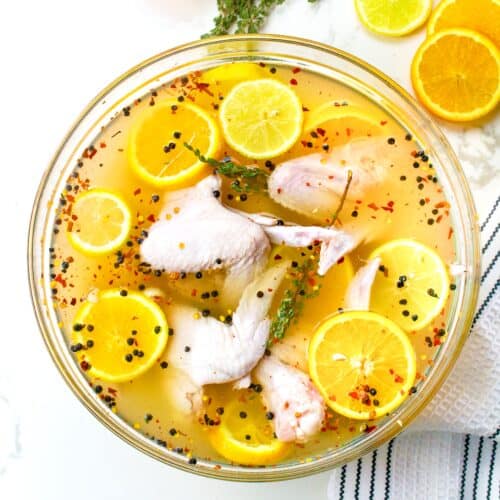
Chicken Wing Brine
Great brine locks in moisture, infuses every bite with seasoning, and takes your homemade wings to a whole new level. Whether you're grilling, frying, or baking, this simple step makes all the difference.Makes 5-6 cups of brine
Servings 4
Calories 393kcal
Ingredients
- 5 cups (1.2l) water (separated)
- 2½ tablespoons (45g) kosher salt
- 2½ tablespoons (30g) brown sugar
- ¼ cup (60ml) apple cider or water
- 1½ pounds (680g) chicken wings (see notes)
- 3 cloves garlic, smashed
- 2 sprigs thyme
- 2 bay leaves
- 1 tablespoon (12g) cracked peppercorn
- 1 tablespoon (4-5g) red pepper flakes (optional)
- 1 large orange, sliced
- 1 lemon, sliced
Instructions
- Heat a cup of water in the microwave or on the stovetop until hot enough to dissolve the sugar and salt but not boiling. Remove it from the heat and pour in the salt and sugar, stirring until they dissolve.
- Add the remaining water and apple cider to cool the brine. It should not be warm—you want it completely cooled.
- Put the chicken wings in a non-reactive pot or glass container and pour the cooled brine over them. Add the garlic, thyme, bay leaves, peppercorns, pepper flakes, orange slices, and lemon slices. Then, cover the pot with a lid or plastic wrap and brine it in the fridge for 45 minutes to an hour. Wings are small, so try not to let them brine for over an hour.
- Remove the chicken wings from your brine and pat them dry with paper towels.
- Brush with butter and rub with your favorite seasoning. You're now ready to grill, bake, or smoke your wings.
Notes
- I like my wings whole, but most people prefer to buy party wings that have been separated into flats and drummettes
- Cool your brine completely before adding it to the chicken. If you're in a hurry, replace some of the cool water with ice cubes to speed up the cooling process
- Brining in a non-reactive container (like glass, porcelain, plastic, or stainless steel) is vital because acidic ingredients (like vinegar or citrus) can react with reactive metals such as aluminum or copper. The same goes for wooden vessels. This reaction can give your wings a metallic taste and may even cause harmful compounds to leach into the food. A non-reactive container keeps your brine clean, safe, and flavor pure
- The nutritional data for this recipe is for the brined chicken wings because people don't usually drink the brine. Please remember that it is a rough estimate and will vary depending on how you cook them
Nutrition
Serving: 4wings | Calories: 393kcal | Carbohydrates: 4g | Protein: 32g | Fat: 27g | Saturated Fat: 8g | Polyunsaturated Fat: 6g | Monounsaturated Fat: 11g | Trans Fat: 0.3g | Cholesterol: 131mg | Sodium: 725mg | Potassium: 316mg | Fiber: 1g | Sugar: 2g | Vitamin A: 364IU | Vitamin C: 10mg | Calcium: 44mg | Iron: 2mg